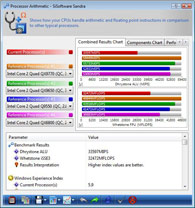AMD Phenom X4 9850 B3 Revision
How We Configured Our Test Systems: When configuring our test systems for this article, we first entered their respective system BIOSes and set each board to its "Optimized" or "High performance Defaults". We then saved the settings, re-entered the BIOS and set memory timings for either DDR2-1066 (AMD) with 5,5,5,15 timings or DDR3-1333 with 7,7,7,20 timings (Intel). The hard drives were then formatted, and Windows Vista Ultimate was installed. When the Windows installation was complete, we updated the OS, and installed the drivers necessary for our components. Auto-Updating and Windows Defender were then disabled and we installed all of our benchmarking software, defragged the hard drives, and ran all of the tests.
|
|
System 1: Asus P5E3 Premium 2x1GB Corsair DDR3-1800 GeForce 8800 GTX WD740 "Raptor" HD Windows Vista Ultimate |
System 2: Gigabyte GA-MA790FX-DQ6 2x1GB Corsair PC2-8500 GeForce 8800 GTX WD740 "Raptor" HD Windows Vista Ultimate |
|
|
We began our testing with SiSoftware's SANDRA XII, the System ANalyzer, Diagnostic and Reporting Assistant. We ran three of the built-in subsystem tests that partially comprise the SANDRA XII suite with AMD's new Phenom X4 9850 processor (CPU Arithmetic, Memory Bandwidth, and Memory Latency) and with a B2 revision Phenom clocked at the exact same frequency for reference. All of the scores reported below were taken with the processors running a clock speed of 2.5GHz, with 2GB of DDR2-1066 RAM running in 128-bit ganged mode. Please note however, the Phenom X4 9850 has a faster memory controller frequency of 2.0GHz, the B2 revision chip had a 1.8GHz memory controller clock.
|
|
||












